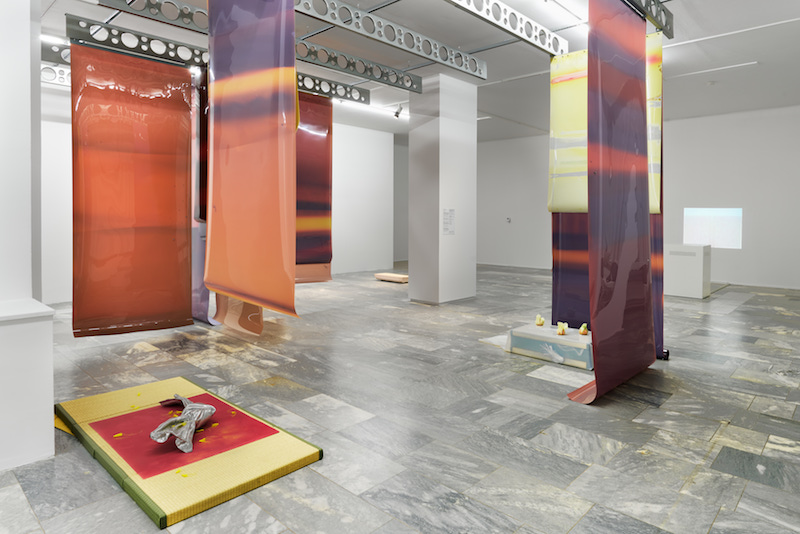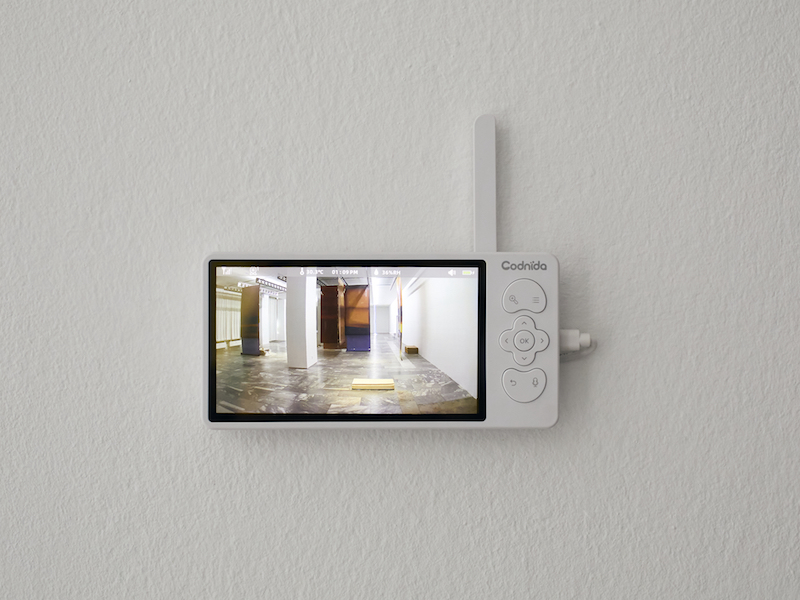by Olivia Ladanyi // Oct. 22, 2024
For a show that purports to question the hierarchy of sight over the other senses, the first room of ‘After Images’ contains lots of things to look at. Hanging sheets of light-sensitive silicone welcome visitors into the space, with low interruptions of knotted aluminium and tangerine sculptures wrapped in paper. But as you walk through the group exhibition at the Julia Stoschek Foundation, the other more marginalised senses perk up—you notice the jarring sound of a ball moving around a metal box and an eerie background jingle that has probably been playing the entire time without you realising.

Lotus L. Kang: ‘In Cascades,’ 2024, installation view, ‘AFTER IMAGES’ at JSF Berlin, dimensions variable // Photo by Alwin Lay
Through tactile installations that beg to be touched, unnerving scents that creep up on you and haunting sounds emitted from unknown sources, ‘After Images’ subtly interrogates contemporary visual culture while working hard to redefine our relationship with it. Galleries aren’t spaces where we’re usually encouraged to flex any of the other senses. Quite the opposite—littered with real or imagined ‘Do not touch’ warning signs and barriers keeping you at a distance—image culture is generally there to be looked at, not touched or interacted with. But inside ‘After Images,’ visitors run their hands through David Medalla’s foaming soap sculpture, ‘Cloud Canyons,’ with half-trepidatious, half-thrilled expressions dancing across their features.

David Medalla: ‘Cloud Canyons,’ 1963/2018, sculpture, metal, acrylic glass, compressors, timers, water, soap, installation view, ‘AFTER IMAGES’ at JSF Berlin // Photo by Alwin Lay
According to Aristotle’s hierarchy of the senses, touch is the least important for survival and experiencing the world, with sight ranking first. 17 centuries later, ‘After Images’ and the 30 artists whose work it features, challenge this proposed ranking, asking: what if we rearranged the order? The exhibition is a contemporary proposal of what comes after images. It questions, “What forms of agency, empathy, and respite lie in such a recalibration of the senses?” In a cultural context where we are overexposed to images daily, numbed to the sight of suffering, beauty and pain in image form, explorations of sensorial alternatives are not only enlightening but necessary. Maybe, as ‘After Images’ asserts, images have served their purpose in visual culture and we need to ask ourselves, what’s next?

LABOUR: ‘Tower of Silence,’ 1963/2018, mixed media installation, sculpture, sound, seating, 333.42 x 120.73 cm, installation view, ‘AFTER IMAGES’ at JSF Berlin // Photo by Alwin Lay
One of the show’s most sensorial rooms contains LABOUR’s multi-media installation, ‘Tower of Silence,’ an “expansive sonic activation” where a serpent-like form looms over seven plinths to the eerie tinkle of a sci-fi soundscape. A ferocious moving spotlight casts a long shadow, slicing the room in half. Pulling the curtain back and stepping into the dark, smoky room, each of the senses sharpens, as if in order to protect oneself from a perceived danger. Perhaps a fear of the unknown or of what lies in the strange room where nothing is identifiable, but everything recalls something familiar yet not quite within grasp.

Paul Chan: ‘Too Phantasia 4,’ 2024, sculpture, fans, synthetic and natural fabrics, metal, cords, shoes, concrete, 203.2 x 304.8 x 213.4 cm, installation view, ‘AFTER IMAGES’ at JSF Berlin // Photo by Alwin Lay
‘After Images’ even experiments with proprioception (or depth perception)—one of the most underrated senses, not even making it into the five. An immersive extended reality experience places haptic, virtual objects—shimmering space rocks and spinning playing cards—in the room for you to reach out and touch, push away or disintegrate with your fingers. While this creates a visually ridiculous scene to observe from the outside, headset wearers get to play inside an integration of virtual and physical spheres, where these virtual objects feel just as tangible as the real ones they float above.

Ghislaine Leung: ‘Monitors,’ 2022, baby monitor installed in one room and broadcast to another, installation view, ‘AFTER IMAGES’ at JSF Berlin // Photo by Robert Hamacher
A baby monitor links the two floors, capturing the sounds and movements visitors make downstairs and screening them on the second floor. Ascending the stairs, running water hits your eardrums before you come face-to-face with the other side of the baby monitor. On this level, the multi-sensory experience continues with billowing inflated forms, whirring fans, blowing ventilators, flickering screens and clicking projectors: archaic audio-visual tech that nostalgically teases the senses. In one room, a fossilized whale’s inner ear bones sit on the floor as underwater noises play. These time-based, olfactory, kinetic, haptic and experiential installations make a mockery of the idea that sight is somehow more valuable than the other senses, revealing it for what it is—an amalgam of sensory feedback from the entire body. ‘After Images’ firmly demotes the role of images in modern culture, persuasively recalibrating it as not the, but just one, way of making sense of the world.
Exhibition Info
Julia Stoschek Foundation
Group Show: ‘After Images’
Exhibition: Sept. 12, 2024–Apr. 27, 2025
jsfoundation.art
Leipziger Straße 60, 13599 Berlin, click here for map



















